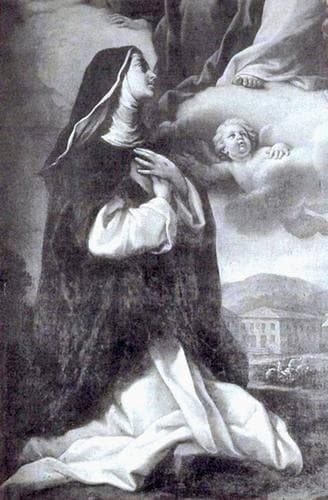
Blessed Lucy Of Narni
Blessed
Feast Day: November 15
Birth: December 13, 1476
Death: November 15, 1544
Biography
Blessed Lucy of Narni, also known as Lucy Brocolelli, Lucy de Alessio, Lucia Broccadelli, or Lucia Brocadelli, was born on 13 December 1476 in Narni, Umbria, Italy, to Bartolomeo Broccadelli and Gentilina Cassio. She was the eldest of eleven children in a devout Catholic family. From a young age, Lucy displayed exceptional piety and spiritual devotion.
At the tender age of five, Lucy received a vision of the Blessed Virgin Mary. The apparition deeply impacted her, strengthening her faith and leading her on the path of holiness. Two years later, at the age of seven, she was visited by both Mary and Saint Dominic de Guzman, who bestowed upon her a scapular.
By the time she turned twelve, Lucy had already taken private vows and made the decision to join the Dominican order. However, her plans were impeded by the death of her father. She was placed under the care of her uncle and, at the age of 15, was betrothed in an arranged marriage to Count Pietro de Alessio of Milan, Italy.
Lucy found herself torn between her affection for Pietro and her strong desire for the religious life. This internal conflict caused her severe stress, resulting in illness. However, in a vision, Mary, Saint Dominic, and Saint Catherine appeared to her, bringing solace and guidance. Despite her initial reluctance, Lucy eventually married Pietro, who understood and agreed that they would live chastely as brother and sister.
Taking charge of the count's household, Lucy dedicated herself to serving others. She instructed the household's servants in catechism, extended care to the local poor, and spent her evenings in deep prayer. The servants claimed to have witnessed supernatural occurrences, such as Saint Catherine, Saint Agnes of Rome, and Saint Agnes of Montepulciano helping Lucy bake bread for the impoverished.
At one point, Lucy felt compelled to walk away from her marital home and become an anchorite. However, Saint Dominic intervened, informing her that she had other work to accomplish. Concerned for her well-being, Pietro had her locked up under apparent pretenses of safeguarding her. This incident strained their relationship to the breaking point, and shortly afterward, Lucy returned to her mother's home.
Following these events, Pietro experienced a conversion and eventually joined the Franciscan order as a notable preacher.
In 1496, Lucy relocated to Viterbo, Italy, and joined a group of Dominican tertiaries. Her spiritual experiences continued to develop, often leading her into states of ecstasy during prayer. She also began to manifest the stigmata, the wounds of Christ's crucifixion, on her body. News of her visions and extraordinary actions spread, attracting curious spectators.
The bishop of Viterbo personally investigated Lucy's mysticism but was unable to reach a definitive conclusion. Consequently, he referred her case to the Inquisition, who likewise found themselves unable to provide a verdict. The matter was then forwarded to the Vatican.
With the assistance of Blessed Columba of Rieti, Pope Clement XI investigated Lucy's mystical signs and, satisfied with their authenticity, sought her prayers. Consequently, Lucy returned to Viterbo, where locals celebrated her presence.
However, the Count of Ferrara, who had recently established the Convent of Saint Catherine of Siena in Narni, Italy, requested Lucy's service as prioress. Lucy accepted this offer with the intention of promoting a strict observance within the convent. Unfortunately, this sparked a two-year conflict between Narni and Viterbo, culminating in armed conflict when the count dispatched troops to escort Lucy to the convent in 1499.
Once at the convent, Lucy faced additional challenges. Many novices struggled to adhere to the rigorous regulations, leading to a somewhat chaotic environment. Furthermore, the count frequently brought visitors to the convent, parading Lucy as a spectacle and demanding she display signs of stigmata.
In 1505, the Dominicans replaced Lucy as prioress, and the new superior imposed confinement on her. For the remaining 39 years of her life, Lucy lived in silence, speaking solely to her confessor, remaining obedient and never complaining. She was utterly forgotten by the outside world and devoted all her free time to prayer, often experiencing ecstasies and receiving visions.
Blessed Lucy of Narni passed away on 15 November 1544 at the Saint Catherine of Siena convent in Ferrara, Italy, from natural causes. Numerous miracles were reported at her tomb, attracting individuals who sought solace and healing. Her remains were reinterred twice, making it more accessible for pilgrims, before finally being interred in the cathedral in Ferrara. Remarkably, her body remains incorrupt to this day.
Blessed Lucy of Narni was beatified on 1 March 1710 by Pope Clement XI, who confirmed her cultus. Her life serves as a testament to her unwavering faith, her deep spirituality, and her commitment to serving others despite the personal sacrifices she made.